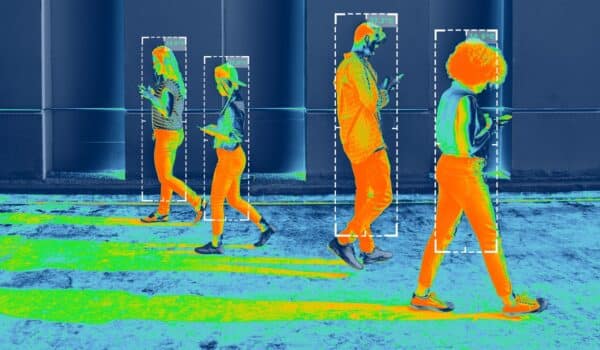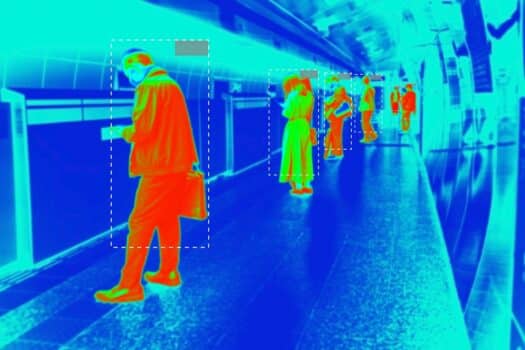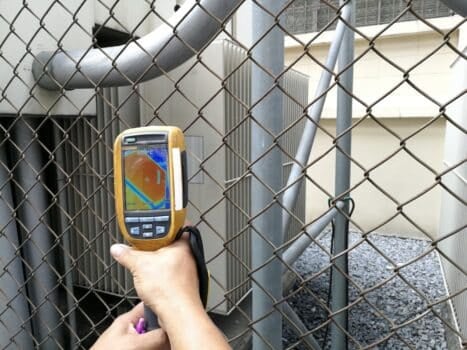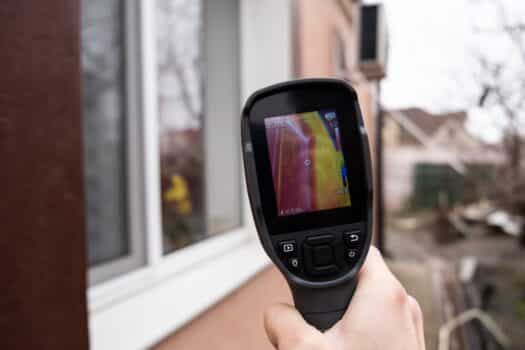Thermal imaging, also known as infrared thermography, involves capturing an image using a thermal camera with the help of infrared radiation. The main purpose of this technique is to allow an object or environment to be seen even in the absence of visible light.
With civilian uses of thermal imaging increasing rapidly, it has become much easier to get a thermal imaging camera.
But before you head out to get such a camera, it is important to learn about the thermal imaging process in detail. This will help you understand its uses and advantages, as well as the complexities and problems involved.
So, check out this guide on the subject to learn more.
What Is Thermal Imaging?

Thermal imaging or infrared thermography is a process that makes use of a thermal camera to capture an image of an object using its infrared radiation. The images generated represent the differences in temperature in an object or an environment, and the process is one of the important ones studied under infrared imaging science.
Thermography involves using thermal cameras, which are capable of detecting radiation in the electromagnetic spectrum. These cameras work in the long-infrared range of the spectrum, which lies between 9,000 and 14,000 nanometers, and the images so generated are called thermograms.
What makes thermal imaging so useful is its wide applicability, which is due to the fact that all bodies with a temperature over absolute zero emit infrared radiation. This means that objects and environments can be easily seen even in the absence of light, and temperature variations can be seen since bodies with higher temperatures emit more radiation.
Thermal imaging cameras can help see warmer objects since these tend to stand out against the surrounding environment that has a lower temperature. So, warm-blooded animals, including humans, are easily visible, irrespective of the time of the day. That is the reason why thermal imaging is often used in devices like surveillance cameras and has numerous military applications.
Thermoception
Thermography requires the use of devices like thermal cameras but is similar to a natural process that some animals perform. These animals have certain organs that work in a similar manner and are capable of a basic level of thermal imaging known as thermoception.
Thermoception requires the presence of special receptor cells, generally found in amphibians and fishes, which can help them respond to thermal changes. In other animals, like humans, monkeys, and cats, various receptors can be activated in a similar manner by cooling and warming stimuli.
Active Vs Passive Thermal Imaging
Thermography can be categorized into active and passive types. Active thermal imaging requires an energy source that can help create a temperature difference between the object of focus and its background. It is quite useful in situations where the objects of interest have a temperature close to that of their surroundings.
This type of thermal imaging can also be used to improve the resolution of imaging systems and can help in processes like super-resolution microscopy.
Then there is passive thermography, best used for objects with temperatures higher or lower than the background. It is more commonly used for medical procedures like thermology or for surveillance purposes.
Thermal Imaging Vs Other Types Of Imaging
Thermal imaging can be performed in real-time using different platforms, such as air, water, and land-based vehicles. And compared to other visible imaging techniques, it works through dust, aerosols, smoke, and mists, making it possible to detect bodies even in difficult conditions and environments.
Also, as a passive imaging technique, it can be utilized in daytime and nighttime conditions. This helps in the reduction of disturbances and disruptions in wildlife populations during the collection of wildlife data. And since thermography relies on emissivity, it can detect objects and bodies that are warmer, colder, or have the same temperature as the background.
Similarly, compared to aerial photography, thermal imaging can be used for more versatile applications, such as soil mapping. It can also help understand the effects of shading, which can be used to develop detailed maps.
Thermography Vs Infrared Film
Both thermal imaging and infrared film depend upon infrared radiation but are distinct from each other. While thermography can detect radiation between -50 and 2000 degree Celsius, infrared film detects radiation between 250 and 500 degrees Celsius.
Also, night vision infrared devices work close to the visible spectrum in the near-infrared spectrum and can be used in complete darkness to detect reflected or emitted near-infrared. But because of high-temperature requirements in thermography, they cannot be used for that and are only used with active infrared sources.
And, in the case of starlight type night-vision, these can only magnify ambient light.
CMOS And CCD Thermography
CMOS and CCD sensors work in the wavelength of visible light, but in certain cases, they can be used for getting accurate thermal images. This can be done by using the near-infrared area of the spectrum and can be used for generating images of objects having temperatures close to 280 degrees Celsius.
Additionally, low-cost cameras with CMOS and CCD sensors can be used in the visible spectrum for purposes like pyrometry. These work at temperatures of 600 degrees Celsius and above and can detect heated materials, burning coal particles, soot, etc. Pyrometry generally requires using external filters or Bayer filters while utilizing grayscale, color ratios, or both.
Thermal Camera – Origin And Working

Thermography requires the use of a thermal camera and understanding how this camera works can be quite helpful.
Initially, thermal cameras were developed by the military in the 1950s, and these were heavy and very costly. They also needed to be cooled using liquid nitrogen. Later, with the identification of additional detector materials, newer fabrication techniques, and other technological developments, high-performance thermal cameras came into being.
Cooled focal plane arrays became common during the 1900s, and uncooled ones also began to be used in imaging cameras during this period. Modern thermal imagers use both cooled and uncooled focal plane arrays.
The imaging camera uses an infrared detector with a focal plane array, which can detect pixels and be cooled or uncooled. This depends upon the material which makes up the array and the use for which the camera is intended. Additionally, a lens helps focus the radiation on the detector array while other electronics are present for displaying the thermal image.
To be able to gather useful information from the images, it is vital to strive to get the highest quality of images possible. In most cases, the measurement of the temperatures of the objects is not considered since the focus is on the temperature differences between them. That is why this is such an easy technique to use.
Uses Of Thermography
The most well-known use of thermal imaging is for military purposes and security devices, but there are others as well.
These include medical and clinical ones since this process allows monitoring of physiological changes in warm-blooded animals. That’s why it is used by veterinarians and for detecting human allergies. Thermal imaging was widely used during the 2009 swine flu pandemic when the government utilized it for case detection.
Utilizing thermography for industrial and commercial purposes has also increased rapidly over the past few years. For instance, it is helpful in dealing with fires since it provides firefighters visibility even through smoke.
Similarly, technicians rely on it to locate overheating sections and joints of power lines. Thermography is even used in the construction industry to check for malfunctioning thermal insulation.
And the reason why the use of thermography is increasing is that thermal cameras are quite easy to use since they function similarly to camcorders. Also, since these devices can help see the temperature differences clearly, photographs are not required for analysis.
Thermal cameras can also be used to scan electrical systems to detect faults or identify problems with steam traps in heating systems. And they can locate areas suffering from overheating or leaks, thereby helping save energy.
Other thermal imaging applications include condition monitoring, mapping, medical imaging, targeting and night vision, and even nondestructive testing. It is even used in fields like volcanology, process control, peripheral vascular disease screening, diagnostics, and more.
The Role Of Thermal Energy in Thermography
As explained earlier, thermograms or thermal images captured by thermal imaging cameras represent the infrared energy that an object emits. But due to the presence of more than a single source of this radiation, it can be hard to know how much energy is being emitted by a specific object.
Thermal cameras solve this problem since they can interpret and analyze visual data using algorithms to create the right image. They are highly effective because they utilize numerous sources of information to determine the temperature of the object.
The energy that is visible when you use a thermal camera is known as incident radiant power, while emitted radiant power is the power to be measured. Transmitted radiant power is provided to the object from a distant source, and reflected radiant power is reflected by the object from such a source.
In situations where the object radiates more heat, the power will radiate to colder surfaces from warmer ones, meaning that cooler objects will absorb the heat emitted from hotter ones. The transfer of heat is a perpetually occurring phenomenon and is called radiant heat exchange because the product of time and radiant power is radiant energy.
Using various mathematical algorithms, a thermal camera can create an image of electromagnetic radiation in its viewer in JPG format. But the camera has to alter the temperature of the object with its setting that adjusts emissivity for it to be able to act as a non-contact temperature recorder.
The measurement can be altered using algorithms, which can control the ability to transmit a particular medium and its temperature. These factors will also affect the temperature of the object that is being monitored.
Thermography And Emissivity
The property of objects to emit heat or other types of energy is referred to as emissivity, while that of being able to absorb radiation is known as absorptivity.
Various materials have different emissivities, and these depend upon the infrared wavelength and the temperature. For instance, the emissivity of clean metals gets reduced at longer wavelengths, while that of certain dielectric materials like sapphire and quartz tends to increase. Oxides like iron oxide do not witness any change in their emissivity at longer wavelengths.
The emissivity of materials ranges from 0.00, meaning no emissivity, to 1.00, indicating full emissivity. For instance, the emissivity coefficient of silver is 0.2, which indicates it has very low emissivity, while that of asphalt is .98, making it a highly emissive material.
To measure the temperature of an object with an infrared imager, it is crucial to determine its emissivity. A theoretically black body is supposed to have an emissivity of 1, but ordinary objects generally do not emit as much radiation. For certain types of objects, an emissivity chart may help provide this information.
This value is entered into the thermal imager, which can then calculate the contact temperature of the object. Along with the emissivity value, it will use the infrared radiation emitted by the object for the purpose. But for more accurate measurements, thermographers can apply a material like an emissivity spray for industrial purposes or black insulation tape to the surface of the object.
It is then possible to measure actual emissivity by making adjustments to the thermal imager and setting it to the known temperature. That said, in some situations, this emissivity test may not be possible, which is when the tables containing the emissivity values have to be used.
Automation And Thermography
With more and more applications making use of thermography, automated thermal imaging is slowly becoming a reality. Here are some of the ways by which thermography is being used with automation.
Application Of Thermography To Study Animal Ecology
Thermal imaging technology can be used to study animal ecology since it can identify radiation emitted by animals and differentiate them from their surroundings. It can help collect important data regarding the number and type of species present in an area. And this can help in making observations about the physical condition, sex, and age of the animal.
However, while the data can be gathered with the help of thermal radiation, it needs to be processed before any meaningful information can be obtained from it. And processing thermal images is not an easy task. This is because counting the animals present in an area using the thermal images collected requires considerable effort by scientists and researchers.
That is why automating the data collection process plays an important role, especially if a large number of animals need to be counted within a short period. Some of the methods used for this purpose include computer vision analysis, digital image processing, automated motion detection, and the use of tracking and detection algorithms.
Automating The Process Of Detection
Certain challenges exist as far as automating the process of detection of animals is concerned. And among them, the first is related to the quality of the images produced. It is important to have good-quality images to be able to separate the background from the animal signatures.
Also, the number of species in an area can affect the detection and automation processes. In case there is more than a single species present, automation becomes much more complex since the individual signature of each species has to be identified. This requires the development of an algorithm, which may be based on intensity, size, or shape for identification.
But situations that only require the detection of animals instead of identifying each species separately have benefited from developments in this field. For instance, mounting cameras with thermal imaging sensors on a tractor and driving the tractor at varying speeds can help in the detection of animals.
And this can help in processes like agricultural mowing since it can result in close to 100% detection, though dense foliage may affect the detection.
Special methods have been developed for the detection and identification of different species since the process is much more complex. One of the methods developed relies on a new algorithm that can be used with a platform that simulates an unmanned aerial vehicle (UAV).
UAVs can be used in many situations, such as mowing operations, and can be fitted with thermal imagers along with equipment for data processing. They can help reduce animal deaths caused by farming machinery and help in the adoption of farming practices that do not affect wildlife.
Thermography In Agriculture And Forestry
Water And Crop Monitoring
Thermal imaging can be used to study the soil water content and the vegetation of an area, though it can be challenging to draw conclusions from such data. This is because the surface temperature can change quickly, depending on factors like wind, humidity, and others. Also, there is no thermal satellite data that can provide high-resolution images.
That is why automated simulations are used to study the relationships between vegetation, soil, and atmosphere and are known as SVAT models. These are developed using data related to vegetation, climate forcing, and the hydrodynamic properties of the soil. And there are several methods by which the water balance of the soil can be studied using these models.
Stress Detection In Forests
Thermography can be used to gather thermal data of the forest canopy or leaves to learn about the water levels, which can provide information regarding transpiration. This can help scientists know whether the trees are suffering from stress or not.
Thermal cameras can capture minute changes in the forest canopy temperatures, helping identify features like warmer trunks and cooler leaves. Such information can help understand changes caused by stress, such as changes in the carbon absorption capacity of the trees. It can also help assess thermal irregularities in light of various physiological processes.
High-resolution images make it possible to identify individual trees and the changes in temperature between canopy sections that are exposed to the sun and those that are not. And a collection of multiple images over a period of time can highlight changes in transpiration and soil moisture levels, which can be very helpful in situations like drought.
Disadvantages And Limitations Of Thermography

1. High Cost
Thermal cameras are the most important tool required for thermal imaging, but knowing which thermal imaging camera is the best can be quite difficult. This is because such cameras are available at several different price points, depending upon their quality.
High-performance cameras can be very expensive, often costing over $3000 since they contain a bigger pixel array, with the best ones having an array of 1280 x 1024.
On the other hand, cheaper cameras generally have a 40 x 40 array, which can go up to 160 x 120 pixels. Cameras with a smaller pixel array result in lower-quality images, making it hard to identify different targets in the area.
2. Varying Refresh Rates
Apart from the high cost, different cameras have varying refresh rates. Certain cameras may have a refresh rate ranging from five to 15 Hz, while that of others may go up to 180 Hz or higher. They may also differ in the integration of lenses, which can affect the ease of use.
3. Lack Of Irradiance Measurements
Another challenging aspect of thermal imaging is that many thermal cameras lack the irradiance measurements required for generating the final image. This means that the images created without correct measurements of the ambient temperature, distance, relative humidity, and emissivity do not provide correct temperature values.
4. Not Effective In Case Of Fluctuating Temperatures
In the case of certain objects, gathering information can be hard, especially when they may have widely fluctuating temperatures. That said, this problem can be dealt with to a certain extent by utilizing active thermal imaging techniques.
5. Not As Accurate As Contact Measuring Methods
Errors in measurement are also possible in thermography since the generation of images depends upon the heat energy received by the thermal camera. The reason for that is that radiation depends upon factors like a reflection of sunlight and the emissivity of the object. And hence, thermal cameras cannot offer accurate measurements.

What Is Thermal Imaging Final Words
As thermographic technologies continue to develop, the application of thermal imaging techniques is steadily increasing in various fields. Where earlier it was only used for research and defense purposes, nowadays there are several civilian uses of thermography thanks to the greater availability of devices like thermal cameras.
That said, several challenges remain that need to be overcome to truly unlock the full potential of thermal imaging. Among these, the biggest ones involve lowering the cost of good-quality equipment that can result in high-resolution images and improving the accuracy of such devices.
With that said, it is time to conclude this guide, and we’ll see you in the next one with an explanation on why thermal imaging cameras working better at night.


